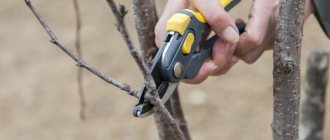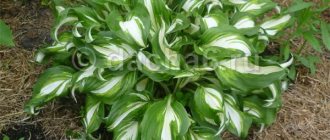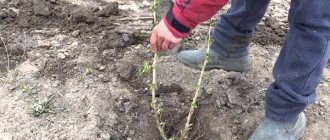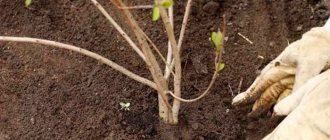Fruits and berries » Currants
0
366
Article rating
Kira Stoletova
Transplanting currants to a new location in the fall can be unexpectedly difficult if you don’t know a few gardening secrets. In order for the bushes to grow luxuriantly and produce a large harvest of delicious berries, it is necessary not only to move the plant correctly, but also to care for it after the procedure.
Autumn transplantation of currants - technique and features
Reason for transplant
When deciding to replant a shrub, you need to know very precisely that this is, in principle, necessary.
A transplant is inevitable if:
- the bush has grown and creates inconvenience for caring for it and picking berries;
- you need to rejuvenate the old plant;
- for a number of reasons, the bush ended up in a shaded or waterlogged area, and to save it there is no other way than to replant the currants;
- the soil under the bushes has become depleted;
- you need to propagate the variety you like.
How to choose the right time for a transplant
It is important to transplant currants to a new place in the fall before the onset of frost. Many experts argue that the end of summer - the beginning of autumn is generally the best time for this, since the plants are preparing for winter, the downward movement of juices predominates in them, and it is not too active, so the bushes will not suffer much from the intervention. In addition, currants transplanted in the fall will begin to grow intensively in the spring and are guaranteed to produce a harvest in the summer.
Summer residents often wonder whether it is possible to replant currants in September. Experience shows that the optimal time for transplanting currants is the period from the 2nd ten-day period of September to the 1st ten-day period of October. Later, it is no longer recommended to do this, because the plant may not have enough time to take root - the bush must take root completely before the onset of frost, otherwise the currant will die in winter.
There are several rules for replanting shrubs. It is necessary to calculate the time in such a way that at least 3 weeks remain from the moment of transplantation until the onset of the first frost. It is also not recommended to start replanting before the 2nd decade of September - at this time it may still be warm enough for the plant to begin to grow intensively. In this case, the currants will devote all their energy to growing new shoots, but will take root poorly and ultimately will not survive the winter.
Experts advise gardeners from the northern regions not to transplant currants to a new place in the fall, since frosts can occur unexpectedly and quite early, and the temperature can drop to significantly negative values. Severe frosts are destructive for weakened plants.
You can replant currants in the fall only if the bush is mature. Young plants, and especially cuttings, cannot be replanted in the fall - their root system is not yet very developed, so they need much more time to take root in a new place.
Methods of transplanting (propagation) currants
There are 3 ways to propagate currant bushes:
- dividing the bush (spring and autumn);
- layering (spring and autumn);
- cuttings - green (in late spring-early summer) and woody (in early spring).
Next, we will talk about the fastest way to transplant (propagate) currants - dividing the bush, as well as propagation by layering.
Transplanting a young and old bush with and without division
Recommendation! Some gardeners advise pouring a couple of buckets of soil directly onto the bush a year before replanting, and in the spring or autumn, dig it up and divide it. The bush should produce many annual shoots from the root, of course, if you water it enough.
Step-by-step instructions for transplanting currants to a new location:
- Dig up a seedling, digging around on all sides, with a distance of 30-40 centimeters from the seedling.
- If you plan to transport, you can tie the branches and wrap the roots in a bag.
- Prepare a planting hole in a new place (depth - 30-40 cm, width or diameter - depending on the size of the bush itself), which should be filled with fertile soil and fertilizers, you can use humus or compost, as well as superphosphate and potassium sulfate (or wood ash ).
- Fill the hole halfway with nutrient soil mixture.
- Pour out a bucket of water.
- Place the bush as a whole (if it’s young, up to 3 years old) or divide it into several independent ones (if it’s old, then you don’t have to divide it, you need to decide according to your desire and need).
- Place the seedling in moist soil and straighten its root system. In this case, the root collar must be buried 10 centimeters below the surface of the earth.
- Cover with soil and compact.
- Water thoroughly (10-12 liters of water).
- Make a hole (trunk circle) and mulch.
- Thoroughly prune the bush, shortening its above-ground part by 80-90%, so that 2-4 buds remain on each branch.
Important! Transplanting a young currant bush is carried out in a similar way, including mandatory pruning.
Video: transplanting a currant bush to a new location
Note! Many gardeners recommend not replanting or transplanting, but discarding a 10-15 year old bush, first propagating it by layering or cuttings. But if you are satisfied with its fruiting, and the reason for replanting is simply the need to change the place, then it’s up to you. In addition, propagation by layering is the fastest and best way to transplant (propagate) an old bush.
Transplantation using propagation by layering
Step-by-step instructions for transplanting currants by propagating them by layering:
- Select a suitable branch from the bush, which is directed away from the bush. This can be either a one-year or two-year shoot.
- Bury the young shoot (2-3 cm with soil), additionally pinning it to the ground (for example, with a wooden slingshot). But the top of the shoot must definitely look out of the ground.
- The only maintenance requirement is that the soil should be kept slightly moist whenever possible.
- After 1 year (that is, next spring or autumn), you will need to cut the seedling from the main bush (if there are several seedlings, then they will also need to be divided). And then dig it up, digging around the circumference (on all sides), making a distance of 20-25 centimeters from the seedling so as not to damage its root system.
- Dig a planting hole (depth - 30-40 cm, width or diameter - 50 cm), which should be filled with humus or compost, add mineral fertilizer ( superphosphate and potassium sulfate or just wood ash ).
- Place the seedling at an angle of 45 degrees. Bury the root collar of the seedling 10 centimeters from the surface of the earth.
- Pour a bucket of water directly onto the seedling.
- Cover with the earth that remains from digging the hole.
- Trim off the entire above-ground part, leaving stubs of 5, maximum 10 centimeters. In this case, 2-4 buds should remain.
- Mulch.
Important! If you cut branches and see that the middle of the trunk is black, then the bush is infected with glassworm . Alternatively, you need to cut the branches even lower to keep the trunk clear.
Video: propagation of currants by layering - the best way to replant an old bush
You can also propagate currant bushes from cuttings .
How to choose the right new place
The place for planting currants must be chosen very carefully. If you choose the wrong place and have to replant the bush again, you will have to wait a very long time for the harvest.
Currant bushes prefer open, moist places without excessive stagnation of water. Lowlands are completely unsuitable for them, since cold air can stagnate in them and excess water often accumulates. The combination of these factors can lead to rot and fungal diseases of the plant.
It is also not worth planting currants on hills - such places are very windy, moisture from the roots will evaporate too quickly, and in winter it is always a little colder on the hills.
You should not choose too shaded areas for replanting - this will inevitably cause a decrease in the yield of the bush. This is especially true for red currants, which are very light-loving. It is advisable to place plants on the south or southwest side of the site, away from large trees that may provide shade.
In addition, do not forget that currants grow very strongly, so it is not recommended to plant them close to paths, fences, or walls of buildings. Such placement may subsequently make it difficult to access the currant bush for picking berries. For the same reason, it is necessary to maintain some distance from other trees and shrubs.
Distinctive features of different types of transplants
Depending on the type, the process of transplanting currants may differ.
black currant
Black currant varieties differ from red currant varieties in terms of care and bush structure.
So, black currants can not be planted for 8 years, and the bush will bear fruit well in the same place. But after this period, the black berries must be planted. It is important to know that black berries are propagated by cuttings, and therefore, in order to plant new shrubs in a new area, it is necessary to cut the cuttings.
See also: When and how to plant currants
red currant
Unlike black-fruited varieties, red currants can grow in one place for 8 years without replanting without damaging the harvest.
In addition, we must take into account that the red berry will bear fruit only in bright sun. Sometimes replanting is one of the simplest ways to propagate red currants, since its varieties are propagated by dividing the bush, which is only possible by replanting.
Soil preparation
If you have already decided when to replant the currants, you need to start preparing the soil. About 20 days before the expected date, you need to apply fertilizers: superphosphate, potassium chloride and organic fertilizers (for example, compost or manure), and then dig up the selected area to evenly distribute nutrients, while simultaneously removing all roots and other parts of weeds.
To transplant currants in the fall in a new place, you need to prepare a planting hole in a few days. When calculating its size, you need to focus on the size of the bush planned for replanting. Usually it is enough to dig a hole 40 cm deep and 60 cm wide. For some varieties of currants that are tall (more than 1.2 m), the hole needs to be dug deeper - about 60 cm.
If you are replanting several bushes at once, keep in mind that the distance between the planting holes should be at least 1.5 meters. This arrangement will prevent the plants from shading each other. We also must not forget that currant bushes are very susceptible to fungal diseases. Isolating them from each other will prevent the disease from spreading if one of the bushes becomes infected.
For white and red currants, it is advisable to add drainage to the bottom of the hole: gravel, broken brick or expanded clay. You can also fill the hole 1/3 with sand. This will be very useful, as it will facilitate the removal of excess moisture, to which white and red currants are very sensitive.
Features of preparation
Currants are tolerant of soil composition. This can be loam, chernozem and other types of soil. Acidity level - slightly acidic or neutral. The site must be flat. If it is a hill, then the water will quickly move away from the roots, which means the plant will not receive enough moisture and nutrients. The occurrence of groundwater is no higher than 1.5 m from the surface.
The selected area should not be in a lowland. Cold air will stagnate there, which is harmful for the bush. The degree of illumination is selected depending on whether the currant is black or red. The distance to the nearest trees should be about 2 m, between the bushes themselves - about 1–1.5 m.
Did you know? About 190 species of currants now grow on Earth. It began to be used in home gardening in Rus' in the 11th century, by replanting ordinary wild shrubs from forests. Breeders received cultivated varieties only in the 16th century.
Preparation of the bush
It is very important to decide in advance when to replant currants. The bush that is planned to be transplanted must be trimmed first - no later than 2-3 weeks before the procedure. This is done to make it easier for the plant to take root in a new place: when replanting, the roots are inevitably injured, and it becomes more difficult for the bush to deliver nutrients to the shoots and leaves, so the excess green mass will only get in the way. For fruiting, the middle parts of the branches are of primary importance - a third of the length, starting from 30-40 cm from the root, therefore, without loss to the harvest, you can trim the ends of the shoots by 1/3. The height of the bush after pruning should be 50-55 cm. Dry branches must be completely removed, as well as branches older than 5 years: shoots older than this age no longer bear fruit. In addition, branches affected by fungal diseases or pests must be removed.
Preparatory stages
Work with the soil takes place much earlier than the transplant itself is scheduled. For the spring procedure, the preparatory stage is recommended in the fall.
Over the summer, you should select the optimal location option, taking into account the requirements of the variety.
Selecting a location
Currants will take root faster in areas where there is plenty of space for development. Preference should be given to open, level areas with a slight slope.
It is strictly prohibited to place shrubs in lowlands, on slopes or marshy lands. It is better to plant it near a fence or a house, but at a distance of 2 meters from the building.
Favorable areas are:
- well lit;
- spacious;
- windless;
- with good neighbors (as far as possible from fruit trees).
In addition, during the preparatory period, which should begin six months before replanting, legumes or green manure plants are planted in selected areas.
Parts of the garden where cereals, potatoes or other root vegetables were grown are also suitable. Gooseberries will be a bad neighbor.
Preparing the soil and planting hole
Work with the soil can be carried out at least a month before the intended procedure. But this rule does not apply to the moment of spring transplantation of currants. Planting holes are prepared in the fall.
Preliminary:
- remove all plant debris;
- during digging, manually remove any roots and plant remains;
- dig a second time using a bayonet or more than a shovel;
- apply fertilizers. It's better to stick to organic matter;
- check the acidity of the soil.
The best way to replenish useful micro and macroelements is considered to be a recipe made from humus (2 buckets) and a kilogram of wood ash. The indicated dosage is calculated per square meter.
Before starting the transplant
Before you start, make sure you know exactly how to properly dig up a currant bush for replanting.
- Orient the bush to the cardinal points. Choose a branch that, for example, faces due north. Label it with something. You can, for example, tie a ribbon to it. This will be necessary later when placing the plant in a new place, since orientation in space is of great importance for the rapid rooting of the bush.
- Then, for convenience, tie the branches in the form of a spindle - slightly pull them up and tie them with a rope. This way you won’t damage them when transporting them to a new place and during the planting process.
- Step back from the trunk about 50 cm and dig a groove about 30 cm deep in a circle. Pull the bases of the branches. The bush should begin to give in. Those roots that hold the plant must be cut off using a bayonet shovel.
How to plant currants in autumn
Autumn planting rules
Planting holes measuring approximately 40x40 cm and 30-35 cm deep are dug two weeks before planting. They are filled three-quarters full with soil from the top layer and left so that the soil settles. How to plant currants in the fall? Before planting, the shoots of the seedling are shortened to 15-20 cm, and the roots are dipped in mash, then the seedling is placed in a planting hole at an angle of 45º so that it is 6-8 cm deeper underground than it grew in the nursery. The shoots are arranged in a fan-shape.
Cover the currant roots with fertile soil, compact it, make a hole around the perimeter of the root circle and pour a bucket of water into it. When the water is absorbed, mulch the tree trunk with humus, peat or dry sand.
Usually, currants are planted in rows, maintaining a distance between bushes of 1-1.25 m, and between rows of 2.5-3 m. For the most part, currants are a self-fertile crop, but cross-pollination increases productivity, so plant several inter-pollinating varieties on the site in separate rows.
How to divide a currant bush for replanting
If you are replanting currants in order to propagate a plant of the variety you like, then during this manipulation the bush will need to be divided. To do this, after you have dug it up, you need to inspect it and evaluate how many parts it can realistically be divided into. Usually the bush is divided into 2-4 parts. Each part must have healthy branches, and the root system must have developed buds, otherwise the plants may die.
After inspection, use a sharp hatchet or pruning shears to divide the bush into the desired parts. The roots need to be washed and treated as usual when transplanting shrubs.
What should be the ideal place for a bush?
The requirements for a new place for currants are quite high; they also depend on the type of plant: red currant, black or more exotic, white and green.
Black currants can be planted in almost any soil, but red currants are better planted in soil with a high sand content. This is due to the fact that this shrub has higher requirements for the level of soil moisture - red currants do not like excess water, as they more often suffer from fungal infections and rot.
The general requirements for the area under the transplanted bushes are as follows:
- The place should be sunny. Any currant loves the sun very much, perhaps the red currant loves it a little more. If black berries can be planted in partial shade, then red currant bushes are planted only on the south side of the plot in open areas. Typically, red currants are planted in the fall in a mixture of sand and soil.
- It is good if the planting area is on a plain. Lowland areas are completely unsuitable for planting bushes; here the plant will begin to hurt, and its roots will simply rot. The currants are also not placed too high, because the bush suffers too much from the wind, and the moisture quickly leaves the ground.
- As predecessors for currants, you need to choose potatoes, corn or beans; you should not plant the bush where there is a lot of weeds or the intertwined roots of previous perennials remain.
- There should be enough space between the transplanted bush and fruit trees or other shrubs on the site. Currants are too susceptible to various infections and pests; they are easily infected from other plants.
- Light loamy soil is most suitable as soil. The acidity of the earth should be neutral or slightly alkaline. If these indicators do not meet the requirements, you will have to work with the composition of the soil when transplanting currants.
Attention! When replanting a currant bush, maintain the correct spacing with other plants, take into account the future growth of all “neighbors,” especially tall ones (trees, for example).
Root treatment before transplanting
Carefully examine the roots of the dug up bush. They should be free from rot, mold and pests. If any of the above is found, the damaged area of the root must be removed. Remember: it is better to have fewer roots, but they will be healthy, than because of one diseased area left out of pity, the whole plant will then die. The healthier the roots are, the easier and faster the currant bush will take root in a new place.
After treating the roots, it is advisable to further disinfect them by placing them in a weak solution of potassium permanganate for 15 minutes.
When is the best time to replant black and red currants?
The choice of time to transplant currants directly depends on the climatic conditions of the region and the characteristics of the planting material. A change of location is necessary in the following cases:
- currants grow in one place for more than 15 years;
- the plantings have grown greatly, and the bushes interfere with each other;
- the plant has stopped developing;
- trees have risen near the currants, shading the bushes;
- redevelopment of the site is necessary.
in autumn
At the end of fruiting, the currant prepares for wintering: the plant sheds its leaves, and sap flow in its tissues slows down. Autumn is the best time to transplant in temperate regions and the south. During this period, the plant already accumulates a sufficient amount of nutrients in the above-ground part and begins to share them with the roots. This facilitates quick adaptation to a new place.
An important condition for obtaining a positive result is the correct choice of weather conditions. The most favorable time for transplantation:
- daytime hours (heat decreases);
- night temperature readings are within + 7–10 degrees;
- increased humidity and periodic precipitation;
- the time remaining before the first frost must be at least 30 days so that the root system can take root in a new location.
The optimal time to move the bush is from mid to late September. During this period, the currant actively increases its suction roots, which promotes rapid establishment. In the south, the dates are shifted to October. Otherwise, re-vegetation will begin, and the shrub will not be able to safely survive the winter.
Important! If the transplant is done too late, the plant will not have time to adapt and will die in the winter even with slight frosts.
In summer
In the summer, currants actively develop and bear fruit, so replanting is carried out only in case of emergency. It is not recommended to replant an adult bush with a powerful root system in the summer, since it most likely will not take root in the new location. Therefore, it is more advisable to postpone the procedure until the fall.
in spring
Spring replanting is recommended in northern regions where heat sets in slowly. Choose a time when the soil and air have already warmed up sufficiently, but sap flow has not begun in the plant tissues. The main indicator is dormant buds on the shoots. Under such conditions, 100% survival rate is guaranteed.
The disadvantage of spring transplantation is the lack of harvest this season. In northern regions, this is often the only way to save a valuable variety that has been attacked by insects or infected with disease. If you leave the transplantation procedure until the fall, the bush will weaken and will not be able to take root.
Moving a bush to a new location
Now that all manipulations are completed, you can transplant the currants to a new location. In the fall, make a mound at the bottom in a previously prepared planting hole. This is necessary for the correct location of the roots when planting. You also need to water the hole well: pour out 1-2 buckets of water and wait until the water is completely absorbed into the soil. There is no need to plant the currant bush directly into the water, otherwise it may become distorted later.
Position the plant relative to the cardinal directions as it grew in the previous place. It was for this purpose that a mark was made on one of the branches.
Place the roots of the bush on a mound in the hole so that they do not bend upward, and begin to cover them with soil. Keep in mind that the root neck should be approximately 5 cm underground. Make sure that there are no voids left around the roots, otherwise excess water will subsequently accumulate in them.
Compact the soil around the bush and form a hole for watering along the tree trunk. Water the transplanted bush well. Water must be added gradually, allowing it to be completely absorbed. After watering, the tree trunk circle needs to be mulched with turf soil or humus, but you can simply sprinkle dry soil on top.
Replanting currants is usually not difficult, but this work requires careful attention. If you do everything correctly, the bushes will definitely take root.
How to transplant currants: step-by-step diagram
Before transplanting, the soil is carefully dug up to destroy pests. The depth of treatment is up to 40 cm. A planting hole is prepared with a depth of up to 50 cm. The soil removed from it is mixed with fertilizers. For 1 m² of area you will need 10 kg of rotted manure or compost, superphosphate - 20-30 g, potassium sulfate - 30 g.
Planting pattern:
- For red currants, make a drainage layer at the bottom from broken bricks, pebbles or other material.
- Then part of the prepared soil mixture is placed in a heap on the bottom of the hole. A bush is installed on it. They orient him to the cardinal points in the same way as he grew up in the same place.
- They begin to fill the hole so that the bush is planted at approximately the same depth as it grew before. The root collar of black currant should be 5 cm below the soil level.
- The bush is watered abundantly.
- If the soil has subsided, then add more and compact it around the bush.
- A layer of mulch is laid in the tree trunk area.
Video: Currant transplantation
Caring for transplanted currants
After transplanting, the bushes need to be given close attention. Be sure to keep the soil around the trunk loose. This will allow the roots to be saturated with oxygen and the moisture necessary for rooting to penetrate freely. Near the bush itself, the soil is loosened to a depth of 7-10 cm, and closer to the irrigation hole - a little deeper, 15-18 cm.











